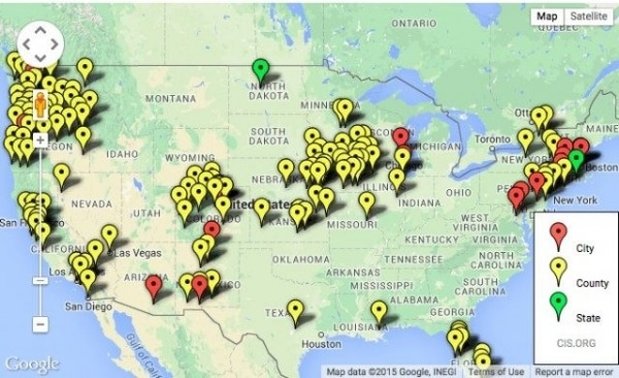
What is a Sanctuary city or a county? Sanctuary cities or counties offer safe harbor for undocumented immigrants who might otherwise be deported by federal immigration law enforcement officials, and refuse to participate in federal efforts to deport city's or county's residents without a proper warrant. Usually, police in a sanctuary city is not interested in immigration status of people arrested or detained, or refuse to honor ICE "detainer" (request "to hold" an alien for ICE without a proper warrant).
There are approximately 140 sanctuary jurisdictions -- cities and counties -- across the U.S., including at least 37 cities -- San Francisco, New York, Chicago, Seattle, Boston and Los Angeles, among others.
You can view a Map of Sanctuary cities, counties and states here .
Новый указ президента от 25 января 2017, касающийся прекращения федерального финансирования городов и округов в США, которые не выдают нелегальных иммигрантов иммиграционной полиции без ордера - Sanctuary Cities and Counties. Read in Russian below.
On Wednesday, January 25, 2017, President Trump signed an executive order that would withhold federal grant money from sanctuary cities.
"Jurisdictions that willfully refuse to comply with federal immigration laws," the order says, “are not eligible to receive Federal grants, except as deemed necessary for law enforcement purposes by the attorney general or the secretary."
Many mayors, including Chicago, Bay Area's largest cities, Oakland, San Francisco and San Jose, and the City of Berkeley said they’d defy the order.
However, this Executive Order scared many city officials who are afraid to lose federal funding for their programs. A day after president signed the order, Miami-Dade County Mayor ordered officials to abandon a sanctuary city status, and ordered county jails to begin complying with federal immigration detention demands, becoming the first mayor to abandon the sanctuary status over the fear that his city would lose millions in federal funds.
The Executive Order does not specify how much or what kind of funding would be or could be blocked, although White House press secretary said that the homeland security secretary would “look at funding streams that are going to those cities and look at how we can defund those streams.”
Just a bit of statistics. In 2016, a Justice Department inspector general’s report investigated how much in Justice Department federal grants some sanctuary jurisdictions receive (as of Mar. 2016). Over 60 percent of the funding goes to 10 jurisdictions identified by the report:
- Connecticut: $69,305,444
- California $132,409,635
- Orleans Parish, Louisiana: $4,737,964
- New York, New York: $60,091,942
- Philadelphia, Pennsylvania: $16,505,312
- Cook County, Illinois: $6,018,544
- Chicago, Illinois: $28,523,222
- Miami-Dade County, Florida: $10,778,815
- Milwaukee, Wisconsin: $7,539,572
- Clark County, Nevada: $6,257,951
As reported by The Hill, new Executive Order on sanctuary cities is unlikely to threaten their federal funding.
Sec. 9 of the Order clarifies that “sanctuary jurisdictions” are those that “willfully refuse to comply with 8 U.S.C. 1373.” The administration intends to withhold Federal grants from those jurisdictions, “except as deemed necessary for law enforcement purposes,” and from any that have a policy that “prevents or hinders the enforcement of Federal law."
In fact, the EO is extremely narrow in scope, and the many reports of cities like Boston and Los Angeles being under threat of losing millions of dollars are simply wrong.
8 U.S.C. 1373 bans state and local policies that prohibit the sharing of information with the federal government about the immigration status of an individual.
However, while there is no uniform set of actions being implemented by sanctuary cities, few, if any, have policies in place that actually conflict with this particular federal law. Instead, they generally do one of two things, or both:
1) Ban law enforcement from asking a person about their immigration status.
2) Prohibit keeping a person in jail beyond the time they’re required to be there upon receipt of a federal immigration detainer request.
Number one basically creates an end-run. This won’t trigger a withdrawal of federal funds under 8 U.S.C. 1373 because agencies can’t share information they don’t have.
Number two has already proven to be particularly troublesome for the federal government, and will likely continue to be so.
Sec. 7 of his order calls for the hiring of 10,000 additional ICE immigration officers.
It is important to keep in mind that under the anti-commandeering doctrine, the Supreme Court has long-held that the federal government cannot force state or local governments to implement or enforce federal laws or regulatory programs.
For example, in the 1842 case, Prigg v. Pennsylvania, the Court held that while the federal Fugitive Slave Act could not be physically impeded by states, they simply weren’t required to help the federal government capture runaway slaves and return them to bondage in the South.
And in the 2012 case, N.F.I.B v. Sebelius, the Court held that states can’t be forced to expand their Medicaid programs, even under the threat of losing federal funding, as the Affordable Care Act attempted to do.
Sec. 8 of new EO explains how the new administration intends to do so: the federal government intends to “empower State and local law enforcement agencies … to perform the functions of an immigration officer.” To achieve that goal the Secretary of the Department of Homeland Security (DHS) is directed to work with governors and local officials to “enter into agreements” to perform federal immigration enforcement duties. The order also includes a big caveat, the agreements will be made “with the consent of State or local officials, as appropriate.”
In short, while Trump is certainly ramping up the pressure to fulfill campaign promises to take on “sanctuary cities,” should cities and states hold fast in their policies, they’ll likely come out on top in court, and on the ground.
Briefly in Russian:
Новый указ президента от 25 января 2017, касающийся прекращения федерального финансирования городов и округов в США, которые не выдают нелегальных иммигрантов иммиграционной полиции без ордера - Sanctuary Cities and Counties.
25 января 2017 новый президент подписал указ о прекращении федерального финансирования некоторых программ в тех городах и округах США, которые отказываются выдавать нелегальных иммигрантов полиции.
Что такое город или округ, кторый не выдает нелагальных иммигрантов федеральной иммиграционной полиции США? Как именно они это делают?
В США около 140 городов и округов, которые считаются sanctuary cities. Карта таких городов может быть найдена тут. Например, Чикаго, Сан Франциско, Сиэттл, Бостон, Лос Анджелес.
По некоторым данным, даже округ Дуглас, в котором находится город Омаха, штат Небраска, а также Сарпи округ и Ланкастер округ все они в настоящий момент являются такими округами.
Но Мэр города Омаха и прокурор округа Ланкастер сразу же после выхода нового указа выступили с заявлением, что город Омаха не является sanctuary city, и поэтому новый указ президента на Омаху не распространяется, и в результате город не должен потерять никаких федеральных грантов.
Как города о округа поддерживают такой статус и зачем это нужно?
Полиция в таких городах считает, что их основная работа - это борьба с преступностью и обеспечение порядка. И в их обязанности не входит выяснение иммиграционного статуса (или отсутствие статуса/визы) у нарушителей закона (например, при обычной остановке водителя за нарушение правил). То есть полиция в таких городах просто этих вопросов не задает задержанным лицам.
Или же второй вариант, полиция и тюрьмы в таких городах и округах отказываются держать в заключении иностранца (за счет города) после того, как его срок задержания под стражей истек, и если иммиграционная полиция вместе с дитейнером (запросом "подержать этого гражданина под стражей подольше для ICE") не получила официальный ордер на арест и задержание.
Это конституционная норма, что отдельные штаты не могут устанавливать свои иммиграционные законы (это прерогатива федерального правительства), и как следствие, во многих случаях штаты и города не обязаны помогать федеральному правительству с депортацией иммигрантов (так как это дело федеральных органов власти и полиции).
Суть нового указа президента заключается в том, что хотя федеральное правительство США не имеет право заставить отдельные штаты помогать им в области иммиграции и депортации, НО они пытаются принудить города и штаты к сотрудничеству, путем угрозы удержания федерального финансирования.




 RSS Feed
RSS Feed